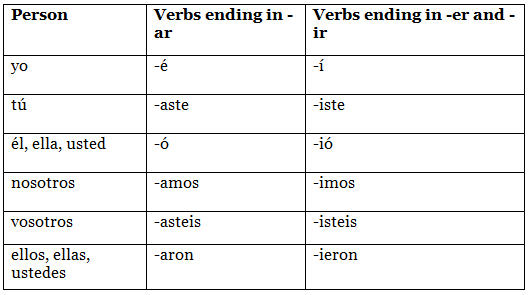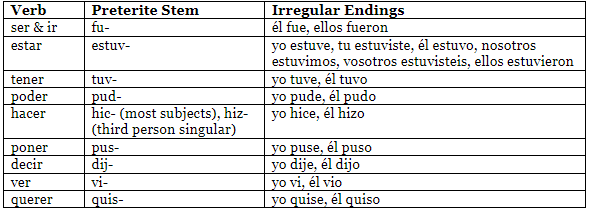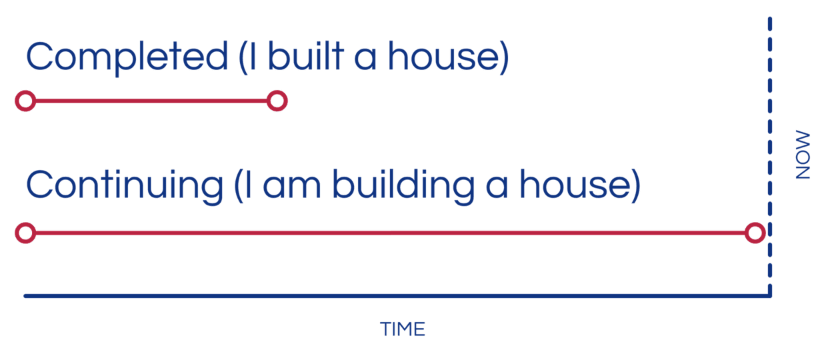The Spanish Past Tense | Spanish: Elementary A2 Level - Class 6 PDF Download
The Spanish preterite tense is one of five forms used to describe actions or events that occurred in the past. The preterite is used to describe actions which have been completed.
Spanish verbs come in three categories (-ar, -ir, and -er) and change (“conjugate”) according to who performed it and when the action occurred.
To form the preterite in Spanish with regular verbs, remove the -ar, -ir, or -er and add the appropriate ending from the chart below.

Note that the nosotros form is the same as the present tense form. Adding temporal expressions such as ayer (yesterday) helps speakers distinguish when something took place.
See our guide on Spanish pronouns if you need to brush up on the subject pronouns found in the “Person” category above.
Irregular Preterite Verbs
All regular verbs can be transformed into the preterite tense easily. Irregular verb conjugations take some memorization.
Fortunately, many of the most common irregular preterite verbs follow patterns, consisting of a new stem and different endings for a few subjects. If you’re not familiar with these verbs, here are 50 common irregular preterite Spanish verbs to get you started.
Another interesting phenomenon to note is that the ser and ir preterite conjugations are identical.

When to Use Preterite
The preterite form of past tense should feel familiar to English speakers, as it is very similar to the English simple past tense (jump + -ed = jumped). However, English speakers should be careful not to overuse the preterite when other Spanish past tense forms would be more appropriate, such as the imperfect for ongoing actions.
Completed Actions in the Past
Spanish past tense forms allow speakers to use a convenient verb ending to express for how long an action occurred, whether it is habitual, or whether it was completed. English still expresses these important distinctions, but often with a combination of verb tenses and extra auxiliary verbs.
As we are focusing on the preterite in this guide, we will illustrate what a “completed” action means by contrasting it with an “ongoing” action. In English, we often use “have been” or “used to” to denote that an action is continuous (“progressive”), ongoing, or habitual. Consider the difference in meaning between the following examples:
1a) I have been attending class / I used to attend class. (habitual) 1b) I attended class.
2a) I am building a house. (continuous/ongoing) 2b) I built a house.

1a denotes a habitual action and is interpreted to mean that someone has been attending class regularly for some time.
2a denotes a continuous action, which has occurred in the past but is still ongoing. In English we use the present continuous to describe this action, while Spanish uses a similar form made up of the verb estar + the gerund (gerundio a.k.a. verb form ending in -ing in English and -iendo/-ando). If the action was ongoing or in progress in the past, the imperfecto (imperfect) form is used.
In 1b and 2b, it is clear that the specific action is complete. 1b conveys that you attended a specific occurrence of a class (which one is implied from the context of the conversation, perhaps a class earlier that day). 2b conveys that the house is complete.
Now that you have an idea of what we mean when we say that an action is complete, let’s see other examples of when to use the preterite tense.
Starts and Stops
The Spanish preterite is used to talk about beginnings and endings of events, often using the verbs comenzar (to begin), empezar (to start), terminar (to finish), and acabar (to end).
La fiesta terminó cuando se fue (The party ended when he left).
This may be confusing when speaking about the beginning of something, as it seems that the event described is ongoing. However, consider the difference between the duration of the action here:
1a) Empezó a llover ayer (It started raining yesterday). 1b) Recuerdo que siempre llovía en aquel pueblo (I remember it always rained in that village).
When Mentioning Specific Dates or Times
- The preterite is appropriate whenever you include a temporal phrase denoting a specific time or day that something occurred.
- Mi hermana nació el pasado abril (My sister was born last April).
- Ella vivió en Costa Rica durante un mes (She lived in Costa Rica for one month).
- Llegué al hotel ayer a las siete de la tarde (I arrived at the hotel yesterday at seven in the evening).
Ordered Actions
- The preterite can also communicate that actions were part of a chain of events or were repeated a certain number of times.
- Abrió la caja, vio al gatito, y sonrió (He/She opened the box, saw the kitten, and smiled).
- Comí tres churros ayer (I ate three churros yesterday).
Interrupted Actions
The preterite is used when an ongoing event (denoted with the verb phrase “estar” (in imperfect) + gerund (verb form ending with -iendo or -ando in Spanish and -ing in English) was interrupted by another event.
Estaba (imperfect) durmiendo (gerund) cuando mi perro ladró (preterite) ruidosamente (I was sleeping when my dog barked loudly).
Estaba (imperfect) corriendo (gerund) cuando se me rompió (preterite) el zapato (I was running when my shoe broke).
With Certain Verbs and Phrases
Some verbs and temporal phrases are often found with the Spanish preterite.
Check out these examples of temporal phrases that can trigger the preterite:
- una vez (one time)
- ayer (yesterday)
- anteayer (the day before yesterday)
- anoche (last night)
- la semana pasada (last week)
- el año pasado (last year)
- el otro día (the other day)
- entonces (then)
- en aquel momento (at that moment)
- desde el primer momento (from the first moment)*
*Desde el primer momento always triggers use of the preterite.
Some verbs inherently express actions which fall into the semantic categories we described above. Just like the phrases above, these verbs can be used with preterite or imperfect (for descriptive/non-specific cases). For example, these verbs interrupt another ongoing event or state of being:
- cumplir años (to turn an age)
- darse cuenta de (to realize)
- decidir (to decide)
- descubrir (to discover)
- salir (to leave)
- llegar (to arrive)
These verbs describe an event with a very specific, implied ending. When used in the past, these are most often used with the preterite:
- casarse (to get married)
- graduarse (to graduate)
- morir (to die)
- nacer (to be born)
Note that these verbs can also be used with the imperfecto to set the scene (descriptive) or non-specific contexts, but that their meaning changes. For example, notice the difference in meaning in the following sentences:
Ayer estaba en casa y, de repente, llamaron a la puerta. Yesterday I was at home, and, suddenly, there was a knock at the door.
Ayer estuve en casa todo el día. Yesterday I was at home all day.
Don’t forget the tilde
All written accent marks are called tildes in Spanish (tilde = singular). In English, the word “tilde” only refers to the mark found above the letter “n” in Spanish (ñ). Since this article is written in English, we’ll refer to tildes as “accent marks.” The accent marks in Spanish include: á, é, í, ó, ú, ñ, and the symbol diéresis, which looks like this: ü
Accent marks denote a slightly different pronunciation of a given letter and are often crucial to distinguishing between two words written with the same letters. For example, the subject pronoun tú means “you,” while it’s accent-less brother tu is the possessive adjective used to denote that something belongs to the addressee (“your”).
Also, the meanings of words distinguished by accent marks are not always related like the above tú/tu example, e.g., mas (“but”) versus más (“more”). Therefore, it’s important to spend some time listening to the different sounds associated with these letters so that you can correctly produce the different forms of these verbs.
As we are unaccustomed to paying attention to accent marks in English, it is tempting to brush them aside to figure out later. In the case of the Spanish preterite and present tense conjugations, the accent mark is the only thing differentiating the tense and person in first person singular (yo), third person singular (él, ella), and second person formal singular (usted). Because it is customary to leave the subject pronoun out in Spanish, this means that the accent is the only way to differentiate between tenses in the following sentences:
Canté muchas canciones en la fiesta del sábado pasado (I sang many songs at the party last Saturday).
Quieren que cante en la fiesta del sábado (They want me to sing at the party on Saturday).
Knowing the rules for Spanish preterite conjugation is an essential first step to learning how to talk about things that occurred in the past. Memorizing conjugation tables may be helpful at first, but without a lot of practice forming full sentences, you will always be delayed in natural communication while you remember how to apply the rule.
|
12 videos|17 docs|11 tests
|
















